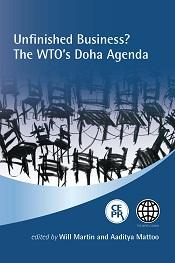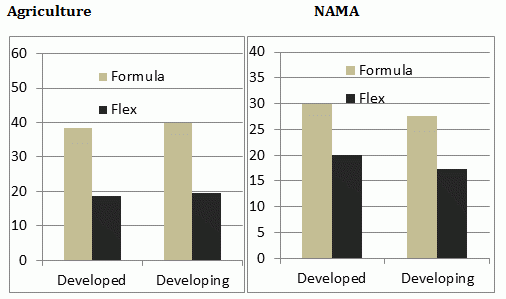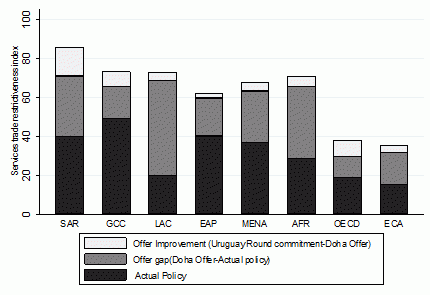The recent G20 communiqué on the Doha Development Agenda (DDA) marks a significant departure from past endorsements and exhortations (Bhagwati and Sutherland 2011). The communiqué acknowledges that “…it is clear that we will not complete the DDA if we continue to conduct negotiations as we have in the past…we need to pursue in 2012 fresh, credible approaches to furthering negotiations, including the issues of concern for Least Developed Countries and, where they can bear fruit, the remaining elements of the DDA mandate. We direct our ministers to work on such approaches at the upcoming ministerial meeting in Geneva and also to engage into discussions on challenges and opportunities to the multilateral trading system in a globalised economy and to report back by the Mexico Summit.”
As ministers embark on this work, a new volume (Martin and Mattoo 2011,
freely downloadable from this site and the World Bank), addresses the key questions they face and provides an empirical basis for informed choices. The questions include:
- What fruit is worth picking, i.e. what benefits do individual elements of the Doha Round currently offer individual participants?
- What are the implications of existing proposals to develop or modify the Doha drafts?
- What have we learnt about “fresh, credible approaches to furthering negotiations” and about new “challenges and opportunities to the multilateral trading system”?
Deconstructing Doha
Enormous time and resources have been devoted to the Doha negotiations, but relatively little to evaluating what has been achieved. Only a few studies, such as Hufbauer et al. (2010) and Bouët and Laborde (2010), provide analyses of the proposals currently on the table. New research in our volume shows that current Doha proposals offer some liberalisation and considerable locking-in of liberalisation that countries have undertaken outside Doha.
Tariff cuts on the table
Widespread scepticism about what the Doha Round will deliver in terms of actual liberalisation has been an impediment to reaching agreement. But this is overplayed. The tariff cuts on the table compare favourably with those achieved in earlier rounds of multilateral negotiations. Even after allowing for flexibilities such as for sensitive and special products, Doha would cut the applied tariffs faced by exporters of agricultural and non-agricultural goods by around 20% (see Figure 1).
- The global real income gains from this market opening alone are conservatively estimated at around $160 billion per year.
- The agricultural proposals also include the abolition of export subsidies, and sharp reductions in maximum levels of domestic agricultural support in the EU and the US.
Locking in liberalisation
A hard-to-quantify but nevertheless significant gain from the negotiations would be greater security of market access. The proposed cuts in legally bound tariffs (an average of 26% in agricultural and 46% in non-agricultural goods) would reduce the current large gaps between applied and bound tariffs and hence the scope for reversals of liberalisation.
These bindings matter because agricultural protection rates have been increasing in today’s developing countries – as they did when today’s rich countries were growing rapidly. In the absence of new disciplines, it is predicted developing country agricultural protection rates may increase from 7% to 35% by 2030.
Figure 1. Percentage cuts in average agricultural and average NAMA tariffs faced
Source: Laborde and Martin Chapters 2 and 3.
Note: NAMA stands for Non-agricultural market access (i.e. tariffs). The Figure shows the reductions in the average tariffs faced by developed and developing countries as a percentage of their current levels. The first bar in each graph shows that the tariff reduction formulas used – both in agriculture and in non-agriculture – would have brought about very sharp reductions in the barriers affecting exporters. The second, darker, bars show the reductions brought about after the flexibilities allowed countries in the negotiations. One of the key messages of the book is that both developed and developing countries would see worthwhile improvements in their market access.
Services: More work needed
In services, current Doha offers are less impressive. They do improve on countries’ previous commitments by on average about 10%, but they would still leave bindings on average twice as restrictive as actual policies. Even with highly probable additional offers in the closing stages of negotiations, Doha will most likely offer modest improvements in security of market access rather than substantial new market access.
Figure 2. Doha services offer improvement, offer gap, and applied policy for 62 countries, by region
Source: Borchert, Gootiiz and Mattoo , Figure 5.7
Elements for least developed nations
The Duty-Free Quota-Free provisions of the agreement are important for the least developed countries. But the impact of these provisions depends heavily on the details – whether all products are included, and whether other developing countries provide access opportunities. Excluding even a small number of products – such as the 3% of products allowed for developed countries in the current drafts – would sharply reduce the value of this improved access for less developed countries.
The ‘Trade Facilitation Agreement’ focuses on trade barriers linked to red-tape, poor infrastructure, and the like. The idea here is to lower the costs of trade by reducing the cost of administrative and regulatory measures, especially in developing countries. In parallel, the ‘aid for trade’ initiative (which seeks to help developing nations produce goods that can be exported) could play a valuable catalytic role in mobilising trade-related assistance directed to reducing trade costs and enhancing export capacity in poor countries.
The unresolved issues
WTO members have disagreed over – among other things – whether there should be a movement to free or freer trade in specific sectors, the design of a special safeguard mechanism (SSM) in agriculture, and the practice of zeroing in anti-dumping actions in the US.
The book offers evidence on each of these issues. Sector-specific free trade agreements could almost treble the expansion in non-agricultural trade but, as we note below, may be hard to reach within the existing negotiating framework. The wide-spread use of the agricultural ‘Special Safeguard Mechanism’ could reduce market access, increase the volatility of world prices and not succeed in stabilising domestic prices. A particular method of calculating below-cost sales, called ‘zeroing’, is also an issue in the negotiations. Zeroing in US antidumping is not yet a big economic issue, but could be a big nuisance for developing country exporters – because over 60% of the products currently subject to US antidumping are exported by developing countries.
These disagreements reflect differences on broader issues. WTO members differ on how far they would like to achieve actual market-opening rather than simply lock-in existing market access. They also differ on how best to achieve security of access, i.e. how far and under what conditions to allow contingent protection (e.g. via safeguard type of action) in return for tighter and more comprehensive bindings.
Fresh and credible approaches
The volume draws lessons on both the method and scope of negotiations. It doesn’t make sense to specify more ambitious liberalisation goals and stick to business-as-usual in terms of how negotiations are pursued.
Existing methods have delivered as much as they could. Achieving greater liberalisation in traditionally requires a radical reform of the negotiating methodology in manufacturing, agriculture, and services.
- First, in negotiating cuts in tariffs, top-down formulas with very sharp reductions in the highest tariffs as used in the Doha negotiations may seem desirable from an economic perspective. However, they generate political costs even more rapidly than economic efficiency gains, and lead to intense pressure for exceptions from the formula.
Better outcomes may be achieved through less aggressive top-down formulas – even proportional cuts – especially if combined with a requirement that countries “pay” for any exceptions.
- Second, in agriculture, the currently limited disciplines on export restrictions reduce the confidence of importers that world markets will be reliable sources of food supplies.
Negotiating disciplines on both import and export restrictions, and dealing explicitly with both food security and price insulation issues, could lead to a more desirable negotiated outcome.
- Third, in services, market access negotiations have floundered in large part because of inadequate attention to creating the regulatory context in which successful liberalisation can take place (Hoekman and Mattoo 2010).
So far, domestic regulation has been considered only in so far as its presence or absence might be an impediment to market access. Little attention has been devoted to identifying and remedying regulatory weaknesses in developing countries, in areas like prudential regulation in financial services or precompetitive regulation in telecommunications services, which is necessary to reap the full benefits of market opening.
Little attention has also been paid to promoting international regulatory cooperation, especially in areas like financial services and labour mobility, without which national regulators are increasingly reluctant to accept any market opening. Most of such regulatory assistance and regulatory cooperation will take place outside the WTO, but by addressing the good reasons for holding back from liberalisation, the WTO’s powerful mechanism for reciprocal liberalisation can be unleashed against the dubious reasons for protection, i.e. the power of vested interests.
Expand the agenda?
Apart from the issue of how to negotiate more effectively the current Doha Round agenda, the WTO must also consider whether to redefine the agenda to include critical trade-related matters that lie outside the Doha Round.
Many issues not on the agenda have assumed increased significance since the Doha Round was launched. For example:
- Trade and trade policy implications of climate change mitigation,
- exchange rate management,
- food security,
- oil and energy security.
The new G20 communiqué is valuable because it liberates negotiators from the straightjacket of the current agenda and gives them freedom and space to consider some of the other issues that now crave multilateral cooperation – though in some cases they crave cooperation not only in the WTO.
Table of Contents for
Unfinished Business: The WTO’s Doha Agenda
1. Introduction by Will Martin, Aaditya Mattoo and Deborah Winkler
2. Agricultural Market Access by David Laborde and Will Martin
3. Non-agricultural Market Access by David Laborde and Will Martin
4. The WTO Agricultural Modalities Proposals and Their Impact on Domestic Support by David Blandford and Tim Josling
5. Services in Doha: What’s on the Table? by Ingo Borchert, Batshur Gootiiz and Aaditya Mattoo
6. Duty Free, a Round for Free and the Least-Developed Countries by Antoine Bouët and David Laborde
7. The Special Safeguard Mechanism: Previous Studies and Present Outlook by Jason Grant and Karl Meilke
8. Doha and Trade Facilitation: Lending Specificity to the Multilateral Trade and Development Agenda by Benjamin J. Taylor and John S. Wilson
9. Aid for Trade: Why, What, and Where Are We? by Bernard Hoekman
10. Potential Real Income Effects of Doha Reforms by David Laborde, Will Martin and Dominique van der Mensbrugghe
11. Sectoral Initiatives in the Doha Round by David Laborde
12. The Hidden Gain of the Doha Round: Lowering the Cost of Trade Wars by Reducing Binding Overhang by Antoine Bouët and David Laborde
13. What’s the Appropriate Agricultural Protection Counterfactual for Trade Analysis? by Kym Anderson and Signe Nelgen
14. US Anti-dumping: Much Ado about Zeroing by Chad P. Bown and Thomas J. Prusa
15. Multilateralism Beyond Doha by Aaditya Mattoo and Arvind Subramanian
References
Bhagwati, J and P Sutherland (editors) (2011), The Doha Round: Setting a Deadline, Defining a Final Deal, Interim Report of the High Level Trade Experts Group, January.
Bouët, A and D Laborde (2010), “Eight years of Doha trade talks: where do we stand?”, Estey Centre Journal of International Law and Trade Policy, 11(2):349-370.
Hoekman, B and A Mattoo (2010), “Services trade liberalisation and regulatory reform: Re-invigorating international cooperation”, VoxEU.org, 24 December.
Hufbauer, G, J Schott, and W Wong (2010), Figuring out the Doha Round, Policy Analysis in International Economics 91, Peterson Institute for International Economics, Washington DC.
Martin, Will, and Aaditya Mattoo (2011), Unfinished Business: The WTO’s Doha Agenda, CEPR and World Bank, London.





